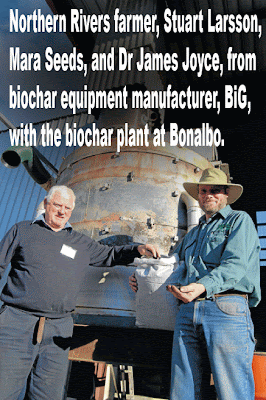Well it seems that the argument goes like this: "Biochar is a pyrolysis process that can be termed as one treatment option under the 'Biomass' banner of treatment options. Biochar has been raised over the last few years as the panacea of treatment options to lock up carbon and apply that to the soil. The technology is unproven and no plant exists in Australia. There have been 2 large overseas plants (Austria - $400M) but both have failed. The treatment option was identified in the report 'Opportunities for Launceston Resource Recovery Facility' by Blue Environment which reported that 'Smaller scale systems are not currently technically or commercial proven for mixed Municipal Solid Waste.' Any research of this technology is at least a state government initiative or more likely a federal issue."
Despite being alerted to the opportunities, and presumably the funding that has been available, the Council recalcitrantly sticks to its lazy thinking an apparently is even refusing to research their options in consultation with a Council that is on its was to making this kind of thinking looking like it is, tiny minded ... click here to read more and see the emerging opportunities
 |
| http://tasmaniansustainablecommunities.blogspot.com.au/p/biochar-pyrolosis_3.html |
Melbourne City Council seems to be on the ball and the case!
 |
| http://www.theland.com.au/news/state/agribusiness/general-news/big-future-for-biochar/2254619.aspx |
If some Councils cannot see ahead farmers seem to able to imagine a better future!

3 comments:
Let's keep it simple and positive for change:
Gerald Dunst introducing his work on fertile soils at Sonnenerde, Austria
Creating humus-rich fertile soils from waste products is Sonnenerde's expertise
The green wastes that communities and households deliver to the composting facility of Gerald Dunst in Austria for disposal are used here as feedstock for making highly fertile humus-rich soils. In 2012, the SME began working with a PYREG plant that converst papermill sludge into Biochar which is then combined with composting of nutrient-rich soils. This mixture is the most promising approach in state-of-the-art Biochar research. Mr Dunst explains his work in this exciting video:
http://cost.european-biochar.org/en/ct/61-Gerald-Dunst-introducing-his-work-on-fertile-soils-at-Sonnenerde,-Austria
I rather thought that thinking about this technology, or set of technologies, as "panaceas" went out the window so many years ago. Why? Because nothing is!
Nevertheless, slothful thinkers will use the argument to close something down in the sure knowledge that they have it right when saying that something they do want to do cannot be done because it is not a "panaceas". That is, it is not the universal remedy it was promised it would be by fools.
But was that ever the promise? In the case of the waste-to-energy-to-biochar scenario it seems that there is good reason to include this set of technologies in a local solution in a local configuration to fit a local situation. It takes a little intelligence to see this and a way forward.
Lethargic thinkers very often cannot be bothered see their own reflection in a mirror.
Burying so called “waste” is really really silly. Bill Mollison told us all a very long time ago that pollution is simply an unutilised resource. So the problem here is actually one with an intellectual dimension or rather the lack of it.
hey Jack I think you wanted to say DO NOT WANT TO DO but anyway you got the message out that they are just a bunch of wasters actually
Post a Comment